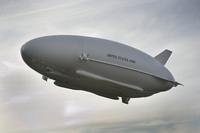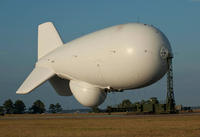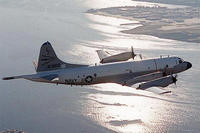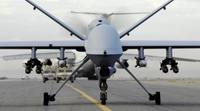-
World’s largest blimp passes flight test

The world’s largest, lighter-than-air, optionally piloted aircraft — the U.S. Army’s Long Endurance Multi-Intelligence Vehicle (LEMV) – completed its first test flight in Lakehurst, New Jersey, the birthplace of the U.S. storied military airship past; the LEMV will provide improved ISR capabilities to the U.S. Army in the form of an “unblinking stare” over ground troops, ranging anywhere from one day to multiple weeks
-
-
First class of U.S. Army soldiers completed training with Raytheon's JLENS

JLENS uses a powerful integrated radar system to detect, track, and target a variety of threats, allowing military units to defend against threats, including hostile cruise missiles, low-flying manned and unmanned aircraft, large caliber rockets, and moving surface vehicles such as boats, SCUD-launchers, automobiles, and tanks
-
-
College buys small UAV for first-responder training program
Sinclair Community College in Dayton, Ohio purchases small unmanned aerial system (SUAS) from UTC Aerospace Systems for use in the college’s training program for first responders
-
-
First ever outdoor flight test of laser powered UAS
Lockheed Martin, LaserMotive, Inc. have completed a series of flight tests of the Stalker Unmanned Aerial System (UAS) to validate the performance of an innovative laser power system
-
-
Silent Falcon solar electric unmanned aerial system unveiled
Silent Falcon UAS Technologies last week unveiled the much anticipated Silent Falcon solar electric unmanned aerial system (UAS) at the Association for Unmanned Vehicle Systems International (AUVSI) conference in Las Vegas
-
-
Manned planes beating drones as the more capable tool in war on drugs

In the never-ending war on drugs, U.S. Navy planes are showing that technology does not necessarily mean improvement, as manned planes are outmaneuvering unmanned drones in catching cocaine smugglers traveling by sea; in 2011 the manned planes caught an average of $30 million of cocaine per day, and during the last five years they have detected more than 853,000 pounds of cocaine
-
-
Drones used by police, firefighters raise privacy concerns
DHS is accelerating the use of unmanned drones by police and firefighters around the country with the intent of detecting fires, radiation leaks, and other potential threats, but Congress and privacy advocacy organizations think the se of drones raises several privacy issues
-
-
UAVs with dexterous arms to help in infrastructure repair and disaster recovery
With current technology, most UAVs perform passive tasks such as surveillance and reconnaissance missions, tasks which are performed well above ground; researchers are interested in how UAVs might interact with objects at or near ground level; a UAV with dexterous arms could perform a wide range of active near-ground missions, from infrastructure repair and disaster recovery to border inspection and agricultural handling
-
-
Researchers say spoofed GPS signals can be countered
From cars to commercial airplanes to military drones, global positioning system (GPS) technology is everywhere — and researchers have known for years that it can be hacked, or as they call it, “spoofed”; the best defense, they say, is to create countermeasures that unscrupulous GPS spoofers can not deceive
-
-
Unmanned systems emulate animals’ conditioned fear-response mechanism for self-preservation
When animals in the wild engage in eating or grazing, their eyes, ears, and sense of smell continuously monitor the environment for any sense of danger; researchers developed a similar conditioned fear-response mechanism for unmanned systems
-
-
UAV Code of Conduct for unmanned aircraft systems operations released
The Association for Unmanned Vehicle Systems International (AUVSI) has published the Unmanned Aircraft System Operations Industry Code of Conduct, a set of guidelines to provide AUVSI members — and those who design, test, and operate unmanned aerial systems (UAS) for public and civil use — with recommendations for their safe, non-intrusive operation
-
-
UAV Code of Conduct for unmanned aircraft systems operations released
The Association for Unmanned Vehicle Systems International (AUVSI) has published the Unmanned Aircraft System Operations Industry Code of Conduct, a set of guidelines to provide AUVSI members — and those who design, test, and operate unmanned aerial systems (UAS) for public and civil use — with recommendations for their safe, non-intrusive operation
-
-
First successful "spoofing" of UAVs demonstrated

A research team successfully demonstrated for the first time that the GPS signals of an unmanned aerial vehicle (UAV), or drone, can be commandeered by an outside source — a discovery that could factor heavily into the implementation of a new federal mandate to allow thousands of civilian drones into the U.S. airspace by 2015
-
-
DARPA’s UAVForge shows challenge of developing perch and stare UAV
DARPA’s UAVForge is a crowdsourcing competition to design, build, and manufacture an advanced small UAV; the competition aims to determine whether a loosely-connected community of UAV enthusiasts could develop a militarily relevant back-pack portable UAV with specific capabilities
-
-
Lawmaker proposes restrictions on domestic drone use
Senator Rand Paul (R-Kentucky) on Tuesday introduced legislation into the Senate which he says aims to protect individual privacy against unwarranted governmental intrusion through the use of the unmanned aerial vehicles commonly known as drones
-
- All
- Regional
- Water
- Biometrics
- Borders/Immig
- Business
- Cybersecurity
- Detection
- Disasters
- Government
- Infrastructure
- International
- Public health
- Public Safety
- Communication interoperabillity
- Emergency services
- Emergency medical services
- Fire
- First response
- IEDs
- Law Enforcement
- Law Enforcement Technology
- Military technology
- Nonlethal weapons
- Nuclear weapons
- Personal protection equipment
- Police
- Notification /alert systems
- Situational awareness
- Weapons systems
- Sci-Tech
- Sector Reports
- Surveillance
- Transportation
Advertising & Marketing: advertise@newswirepubs.com
Editorial: editor@newswirepubs.com
General: info@newswirepubs.com
2010-2011 © News Wire Publications, LLC News Wire Publications, LLC
220 Old Country Road | Suite 200 | Mineola | New York | 11501
Permissions and Policies
Editorial: editor@newswirepubs.com
General: info@newswirepubs.com
2010-2011 © News Wire Publications, LLC News Wire Publications, LLC
220 Old Country Road | Suite 200 | Mineola | New York | 11501
Permissions and Policies
